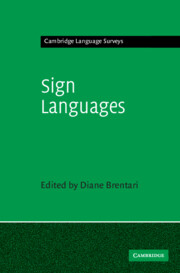Book contents
- Frontmatter
- Contents
- List of figures
- List of tables
- List of contributors
- List of sign language abbreviations
- Notational conventions
- 1 Introduction
- I HISTORY AND TRANSMISSION
- 2 Transmission of sign languages in Northern Europe
- 3 Transmission of sign languages in Latin America
- 4 Transmission of sign languages in the Nordic countries
- 5 Transmission of sign languages in Mediterranean Europe
- 6 Transmission of sign languages in Africa
- 7 Transmission of Polish sign systems
- II SHARED CROSSLINGUISTIC CHARACTERISTICS
- III VARIATION AND CHANGE
- Notes
- References
- Index
3 - Transmission of sign languages in Latin America
from I - HISTORY AND TRANSMISSION
Published online by Cambridge University Press: 05 June 2012
- Frontmatter
- Contents
- List of figures
- List of tables
- List of contributors
- List of sign language abbreviations
- Notational conventions
- 1 Introduction
- I HISTORY AND TRANSMISSION
- 2 Transmission of sign languages in Northern Europe
- 3 Transmission of sign languages in Latin America
- 4 Transmission of sign languages in the Nordic countries
- 5 Transmission of sign languages in Mediterranean Europe
- 6 Transmission of sign languages in Africa
- 7 Transmission of Polish sign systems
- II SHARED CROSSLINGUISTIC CHARACTERISTICS
- III VARIATION AND CHANGE
- Notes
- References
- Index
Summary
Introduction
Language transmission is a natural and hence nearly invisible phenomenon for many of the world's language communities. Typically, and without noticeable difficulty, infants acquire the spoken languages of their families and caregivers. Transmission attracts notice when family languages are not national languages, when children must learn national languages in other contexts, for example through social institutions like schools. This is a common occurrence all over the world, and can have serious impacts on teaching and learning, as well as on relations among families and schools. Often the addition of a national language to the home language in a child's language repertoire does not affect the home language. For example, although a Dutch immigrant child in Vancouver, Canada, may use Dutch for very limited functions and fail to pass it on to her own Canadian-born children, the continuity of the Dutch language itself is not threatened. In other cases, notably those of some sign languages, minority language status threatens the survival of the language itself.
Transmission of sign languages in almost all geographic contexts is difficult to take for granted. The processes it depends on are not obvious, although the problems it confronts reflect the social, political and economic pressures that other minority languages overcome to survive. When a deaf child is born into a hearing family, parents who do not know a natural sign language cannot pass it along to their child. Additionally, hearing loss is usually interpreted as a deviation from normality.
- Type
- Chapter
- Information
- Sign Languages , pp. 46 - 73Publisher: Cambridge University PressPrint publication year: 2010
- 7
- Cited by

